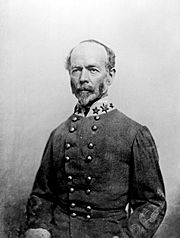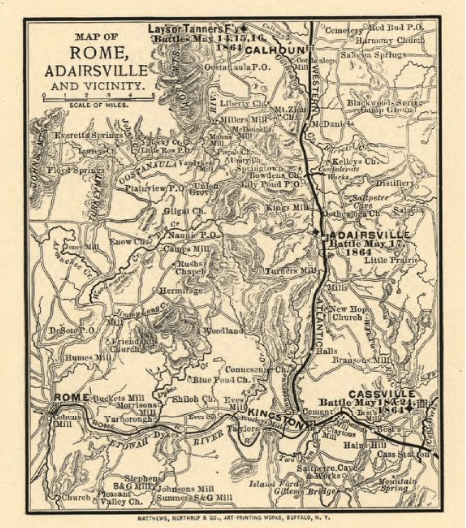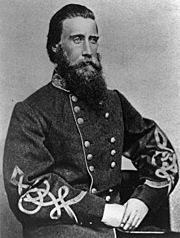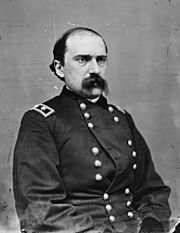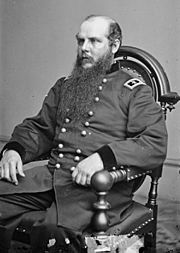Battle of Cassville facts for kids
Quick facts for kids Battle of Cassville |
|||||||
|---|---|---|---|---|---|---|---|
| Part of the American Civil War | |||||||
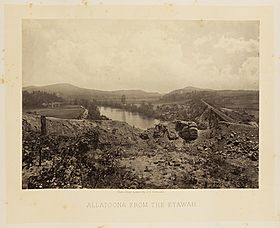 After the clash at Cassville, the Confederate army retreated across the Etowah River, shown in the above photograph. The railroad and bridge are at right, looking south toward Allatoona Pass. |
|||||||
|
|||||||
| Belligerents | |||||||
| Commanders and leaders | |||||||
| Units involved | |||||||
| Military Division of the Mississippi | Army of Tennessee | ||||||
| Strength | |||||||
| 99,000 minus losses | 70,000–74,000 | ||||||
| Casualties and losses | |||||||
| light | light | ||||||
The Battle of Cassville happened on May 19, 1864, during the American Civil War. It was a fight between the Union Army, led by Major General William T. Sherman, and the Confederate Army of Tennessee, led by General Joseph E. Johnston. This battle was part of the larger Atlanta Campaign.
General Johnston tried to surprise a smaller part of Sherman's army. He planned to attack with two of his three main groups of soldiers, called corps. But his plan didn't work because Union soldiers showed up from a direction he didn't expect. Later that day, Johnston moved his army back to a strong defensive spot on a ridge. He waited for Sherman to attack.
However, two of Johnston's corps commanders told him their defenses were weak. They said Union cannons could easily shoot along their lines, making the position impossible to hold. That night, Johnston decided to move his army again. He retreated south across the Etowah River to a new defense line.
The Atlanta Campaign started in early May. Sherman had already forced Johnston to leave his positions at Dalton and Resaca. There was also a smaller fight at Adairsville on May 17. Johnston noticed that Sherman's forces were spread out. So, Johnston gathered most of his army at Cassville. He tricked Sherman into thinking the main Confederate army was retreating to Kingston.
By May 19, most of Johnston's army was at Cassville. They faced only two of Sherman's six infantry corps. Johnston planned to attack the Union forces from two sides. But then, two groups of Union cavalry suddenly appeared behind one of the Confederate corps. This forced Johnston to pull back to a new position. When his new defenses also seemed unsafe, Johnston gave up the Cassville position.
Contents
The Armies Get Ready
Union Army's Strength
In May 1864, General Sherman was in charge of the Military Division of the Mississippi. He gathered a huge army of about 110,000 soldiers. About 99,000 of these soldiers were ready for the campaign. The Union army also had 254 cannons.
Many people who weren't fighting also joined the army. These included railroad workers, medical staff, and teamsters. They helped the army move and stay supplied. Sherman's army was made up of three main parts:
- The Army of the Cumberland, led by Major General George H. Thomas, had about 60,000 soldiers.
- The Army of the Tennessee, led by Major General James B. McPherson, had about 25,000 soldiers.
- The Army of the Ohio, led by Major General John Schofield, had about 14,000 soldiers.
Confederate Army's Strength
General Johnston's Army of Tennessee started with two main groups of infantry. These were led by Lieutenant General William J. Hardee and John Bell Hood. There was also a cavalry group led by Major General Joseph Wheeler.
By April 30, Johnston's army had about 41,000 infantry, 8,400 cavalry, and 3,200 artillerymen with 144 cannons. Later, another group of soldiers joined them. This was Lieutenant General Leonidas Polk's corps, which came from Mississippi. By the time of the battle, Johnston's army had between 70,000 and 74,000 soldiers. About 8,000 non-combatants also supported Johnston's army.
The Campaign So Far
Moving Towards Cassville
The campaign began with the Battle of Rocky Face Ridge. Sherman's plan was to make it look like he was attacking the front of the Confederate lines. Meanwhile, he sent a large part of his army through a hidden path called Snake Creek Gap. This path led to Resaca, Georgia. The Confederates had accidentally left this path unguarded.
Sherman then moved most of his army through Snake Creek Gap. Johnston realized he was being outflanked (meaning the enemy was getting around his side). So, he pulled his army back to Resaca. The Battle of Resaca was fought on May 14–15. During this battle, Union soldiers managed to cross the Oostanaula River. This threatened Johnston's army from behind. Facing this danger, Johnston decided to leave Resaca on the night of May 15. He moved his army to Calhoun.
The Fight at Adairsville
From Resaca, the main railroad went south through Calhoun, Adairsville, and Kingston. Johnston wanted to fight in a place where Sherman couldn't easily get around his smaller army. He looked for a spot where his army's sides would be protected by natural features.
On May 16, Johnston stopped his troops south of Calhoun. But he found the area wasn't good for a battle. So, at 1 AM on May 17, his soldiers moved back to Adairsville. Union cavalry tried to slow down the Union advance. At Adairsville, a Union brigade attacked what they thought was a small Confederate force. But they were wrong. They ran into Johnston's main army and were quickly pushed back. This was the Battle of Adairsville.
After the fight, Johnston decided that Adairsville wasn't a good place for a big battle either. He came up with a new plan. He ordered Hardee's corps and the cavalry to retreat south to Kingston. This would make Sherman think the whole Confederate army was going there. Meanwhile, Hood's and Polk's corps were told to go southeast to Cassville.
From Kingston, Hardee would quickly march east to join the other two corps at Cassville. Then, the Confederates would launch a surprise attack on the nearest Union forces. At the same time, Johnston was told that another Confederate cavalry group would attack Sherman's supply lines.
The Battle of Cassville
Morning Confusion
On the morning of May 18, Union soldiers found that the Confederates had left Adairsville. Sherman was fooled by Johnston's trick. He believed the entire Confederate army had gone to Kingston. Sherman ordered all his infantry groups to meet north of Kingston by the end of the day. But only two of his corps made it that far. The rest of his army was still far away.
General Joseph Hooker reported that he had information about Confederates at Cassville. But Sherman was still sure that Johnston was at Kingston. Meanwhile, a Union division captured Rome, Georgia, which had important workshops.
By the evening of May 18, Johnston's army was set up near Cassville. Polk's corps faced north, blocking the road from Adairsville. Hood's corps was to their right. Hardee's corps covered the road from Kingston on the left. Johnston's army was at its strongest, with about 70,000 to 74,000 men. All three of his corps commanders wanted to attack the Union forces that evening, but Johnston decided not to.
On the morning of May 19, Johnston told his soldiers they would attack. Hood began moving north, planning to swing left and hit Hooker's column. Johnston ordered Polk to attack when Hood did.
At 10:30 AM, as Hood was getting ready to attack, one of his officers saw Union cavalry. They were coming towards Cassville from the east. Hood stopped his attack and told Johnston about the enemy cavalry behind them. Soon after, Hood was told that Union infantry were also marching towards Cassville from the west. Hood decided to pull back to protect the road from the east.
At first, Johnston couldn't believe Union troops were on that road. His own cavalry had just reported it empty. But soon, Johnston ordered his army to retreat to a ridge south of Cassville. The Union forces on the Canton road were cavalry led by Generals George Stoneman and Edward M. McCook. They were on their way to destroy the railroad. This cavalry movement was very important. It stopped Hood from carrying out his planned attack, which could have been very damaging to the Union.
Afternoon Retreat
Union forces took over Kingston on the morning of May 19. This made Sherman believe that Johnston's army had retreated south of the Etowah River. Sherman sent two of his corps east to Cassville. He also sent other troops south to capture the river crossings.
At noon, Union troops marching towards Cassville from the west saw Hardee's Confederate corps. They were lined up as if to attack. But to the surprise of the Union soldiers, Hardee's troops stopped and then pulled back towards Cassville. Johnston himself had chosen a new defensive line along a ridge. This ridge was about 140 feet high and ran from southwest to northeast. At 3 PM, General Thomas wrongly told Sherman that only a small Confederate rearguard was at Cassville. In fact, Johnston's entire army was there.
By 5:30 PM, Hooker's corps was in position on the left of Howard's corps. Sherman was now on the battlefield. He ordered his cannons to fire on the Confederate position. Sherman planned to attack the next morning if the Confederates were still there.
The Confederate chief of artillery, General Francis A. Shoup, warned that the new defenses were weak against Union cannon fire. But Johnston didn't listen to him. More than 40 Union cannons began firing on Johnston's ridge. General Shoup's fears quickly came true. One Confederate division was hit especially hard.
At a meeting with Johnston at 9 PM, General Polk insisted that his troops couldn't hold their position for even an hour if the cannon fire started again in the morning. General Hood said his soldiers could only hold out for two hours.
Johnston believed that if his commanders were so worried, their soldiers would also lose confidence. So, he agreed to retreat, even though he thought the position was defensible. Johnston had other reasons too. He had just learned that Union forces had captured a bridge on the Etowah River. Also, a planned Confederate cavalry raid that would have helped him was canceled. The Confederate army left its lines between midnight and 2 AM. The troops reached Cartersville by dawn on May 20.
What Happened Next
In the morning, the Union troops found that the Confederates were gone. The town of Cassville, which had looked nice that morning, was completely looted by the Union soldiers. One Union soldier wrote that some soldiers were "a disgrace to the service." But he also said that the sooner the Confederate leaders felt the harsh effects of war, the sooner the war would end.
Sherman still thought he was only chasing a small Confederate rearguard. He ordered Thomas's army to camp at Cassville and McPherson's army at Kingston. He sent Schofield's corps to chase the Confederates towards Cartersville. This left Schofield's troops in a risky spot if the Confederate army suddenly turned to fight him. But Johnston was only interested in getting his troops to the south side of the Etowah River. By 8:45 PM on May 20, Schofield's corps reached the Etowah. They found that the railroad and wagon bridges had been destroyed.
The Confederate army took up a new position at Allatoona, near a strong defensive area called Allatoona Pass. Here, Johnston received a message from Confederate President Jefferson Davis. Davis was angry that Johnston had given up so much territory.



